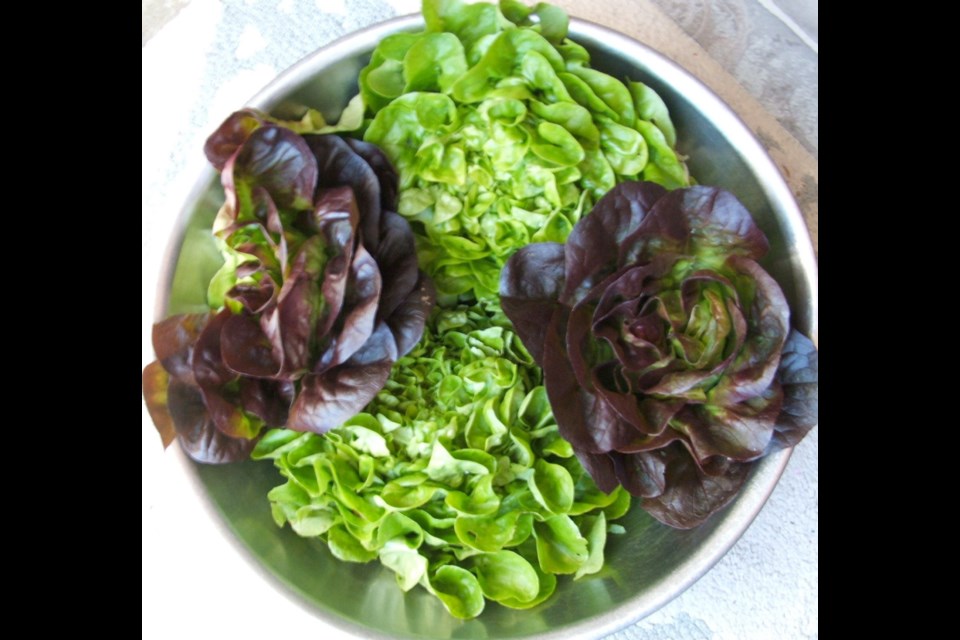Seeding, indoors and out, is underway. Plans are complete for the vegetable garden plantings and some other parts of the garden are gradually taking on a state that at least approaches respectability.
As I seed, weed, tidy and plan, I’m already longing for the first succulent, garden-fresh lettuces of spring, vibrant and beautiful, plump and ready for cutting. The first seedlings are up and I’m hoping for March weather decent enough to set out transplants under plastic tunneling.
Most often, I start the season out with two familiar old-timers, a miniature romaine called Little Gem, and Tom Thumb, ah heirloom miniature butterhead. These compact lettuces deliver surprising yields for their size. Both, but especially Tom Thumb, are tightly and fully packed with sweet, crinkled leaves.
These are the most space-thrifty of lettuces, ideal for small space and container gardens. Both are tasty. They are small, but mighty. West Coast Seeds lists them.
I like these miniatures also for the texture of their leaves. My preference in lettuce is for sturdiness and substance. I want crunch, and juicy succulence. Unappealing are wimpy, limp-leaved lettuces that wilt at the first touch of a vinaigrette.
Lettuces with oomph are found mainly among the romaines and butterheads, though some leaf lettuces offer considerable substance. Among them, my favourites are the oakleaf types.
I like beauty in lettuces. There are many that can light up a vegetable plot and fit well into spaces in ornamental beds. Glistening red butterheads are gorgeous. The unusual Salnovas from Johnny’s Selected Seeds look like big double roses.
Into the past. Lettuce has history. The plants were cultivated during the time of the Pharaohs. They were familiar to the Greeks. Ancient Romans considered lettuce to be an important food. It was during Roman times that lettuce began to be served at the start of a meal instead of at the end. That custom continues today in most places, though in some wine-drinking countries salad comes at the end of a main meal.
I recall from my time cooking for a family in the south of France that salad was the last of several courses eaten at the main, mid-day meal.
Gerard, a herbalist who lived from 1545 to 1612, said of this matter that lettuce may be “eaten at both those times for the health of the body: for being taken before meat it doth many times stir up appetite: and eaten after supper it keepeth away drunkennesse which commeth by the wine; and that is by reason that it staieth the vapours from rising up into the head.”
Seeding. I sow lettuce indoors every few weeks, beginning in February and ending around mid-July. The early seedings allow a head start on the season. Summer indoor sowings protect seeds from high outdoor temperatures that inhibit germination. For fall and winter lettuces I sow outdoors around Aug. 10.
Spring and summer lettuces don’t need a plot of their own. Transplant in between and around pea vines and corn rows, and around young broccoli, cauliflower, Brussels sprouts and zucchini plants. The lettuces will be harvested by the time these larger, longer-term plants can shade them out.
Give lettuces a plump, nourishing soil that is easy to keep consistently moist. In summer, place them in the shade of tall, leafy plants like staked tomatoes.
GARDEN EVENTS
Gordon Head meeting. The Gordon Head Garden Club meets Monday, March 2, at 7 p.m. in Gordon Head United Church, 4201 Tyndall Ave. Michael Cowan from Edibella Organic Landscaping will speak about container gardening, including the cultivation of vegetables and fruit trees. There will be a parlour show and raffle. Visitors are welcome at no charge.
VHS meeting. The Victoria Horticultural Society meets Tuesday at 7:30 p.m. in the Garth Homer Centre, 813 Darwin Ave. Lori Weidenhammer, author of Victory Gardens for Bees, will present Keep them Buzzing: Smart Gardening for Bees. The pre-meeting workshop at 6:30 will feature David Spencer of Applied Bio-nomics speaking about commercially available beneficial insects. Non-member drop-in fee $5.
AGGV lecture series. The second illustrated lecture in the Art Gallery of Greater Victoria series of four lectures will feature art historian Marcus Milwright exploring the history of a walled garden owned by the sultan of Egypt in Botanical Art: Cairo’s Matarea Garden. The lecture will be given on Sunday, March 8, from 2 to 4 p.m. at the gallery. Ticket cost per lecture is $30 for members, others $35. Tickets are available online at aggv.ca, under Events, or at AGGV, 1040 Moss St.



